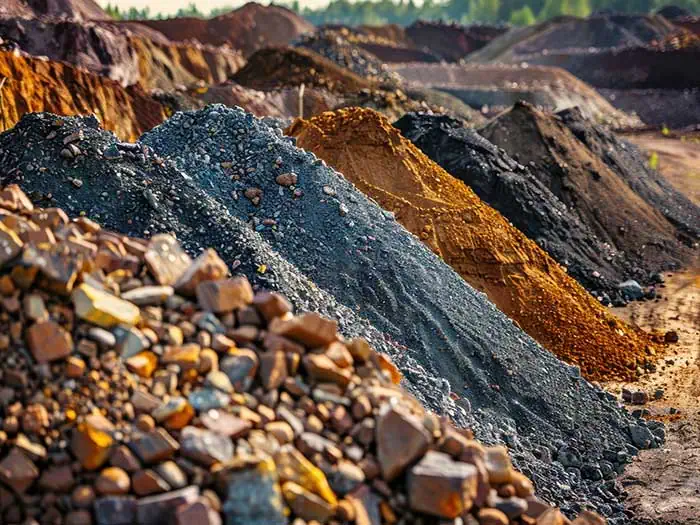


In the United States, increased production of renewable energy products, computer components, catalysts, and superconductors drives an increased need for Rare Earth Elements (REEs). In 2021, the United States government passed the Bipartisan Infrastructure Law (BIL), devoting millions of federal dollars to research and development of technologies to begin domestic production of REEs (SME, 2024).
SCS Engineers is involved in regional assessments of rare earth elements and critical minerals across the United States. Below we describe the process, science, and potential benefits of these studies that aim to help meet the increasing REE demands, provide coal mines with additional markets for their product, and transition coal into feedstocks for the REE market.
Exploration, Characterization, and Extraction for REE Potential
Under exploration are the characterization and extraction efforts within unconventional feedstocks like coal, coal refuse, coal fly ash, acid mine drainage (AMD), mine waste, oil and gas waters, and brines extracted for carbon sequestration. Waste streams related to mining in Pennsylvania also have proven potential for REE production.
Research relating to REE characterization and acquisition within Pennsylvania has identified sources of REEs within coal refuse and AMD. There are approximately 2 billion cubic yards of coal refuse within Pennsylvania (Verba, 2019) and AMD across the commonwealth. Universities and research groups are researching coal refuse and AMD solids in Pennsylvania to determine the viability of REE production.
Appalachian Basin Contains REEs and Treatment Potential
Research finds that host formations within the Appalachian Basin contain clays with REE. In 2019, electron microscopy, image processing, and complementary synchrotron methodologies were used to characterize the Pittsburgh formation. These methods utilized image processing to determine the distribution of the REEs and identified the individual elements, including yttrium, between 1.5-2.4% of the total volume. This method allows for pinpointing coal seams and waste coal refuse containing these clays for REE production once advanced extraction technologies are available (Verba, 2019).
While AMD is a pollutant to waters across Pennsylvania, its acidity can leach REE from host minerals in the surrounding rock. Treatment of AMD produces AMD solid waste in which REEs are present and extractable. Similar to the characterization of the Pittsburgh formation, a study was conducted on AMD solids from three AMD treatment systems using x-ray diffraction, sequential extraction, and synchrotron methodology to characterize REE materials and determine extraction potential. The study concluded that, during the treatment process for AMD, initial REE concentrations in AMD are reduced by 90% and sequestered into solid phases of iron, aluminum, or manganese, of which the manganese (Mn) and aluminum (Al) contain gadolinium and dysprosium. Mobilizing these REEs in AMD solids via sequential extractions with mild acidic and reducing treatments makes AMD solids a potential production source of REEs (Hedin, 2024).
REE Studies Across the United States
SCS Engineers is conducting a regional assessment of rare earth elements and critical minerals in parts of Iowa, Kansas, Missouri, Nebraska, Oklahoma, and the Osage Nation as part of a multi-state effort led by the Kansas Geological Survey. This survey includes a correlation of coal resources in the Cherokee-Forest City Basin via drill cores and coal mine waste to assess this region’s REE and critical mineral potential. This study and the studies in Pennsylvania aim to help meet the increasing REE demands, provide coal mines with additional markets for their product, and transition coal into feedstocks for the REE market.
References
Hedin, Benjamin C.; Stuckman, Mengling Y.; Cravotta III, Charles A.; Lopano, Christina L.; Capo, Rosemary C. (2024). Determination and Prediction of Micro Scale Rare Earth Element Geochemical Associations in Mine Drainage Treatment Wastes.
Society for Mining, Metallurgy, and Exploration (2024). Why the U.S. Needs a National Materials and Minerals Council.
Verba. Circe; Yang, Jonathan; Montross, Scott; Sanville, Henri; Lopano, Christina; and Stuckman, Mengling (2019). Microanalysis of Rare Earth Elements in Coal Prep Fines.
About the Authors:


Related Information:
SCS Joins Search For Domestic Supply of Critical Minerals SCS Engineers is working to complete a regional assessment of rare earth elements and other critical mineral (CM) opportunities within parts of Iowa, Kansas, Missouri, Nebraska, Oklahoma, and…
Solving the Saltation Problem What is Saltation? Wind, sand, and dust storms will become more prevalent as the dry season approaches. One phenomenon that occurs during dust storms is saltation…
SCSers Visit Lithium Valley Early one Saturday morning, SCSers Chuck Houser, Luke Montague, Allison O’Neal, and me, Jen Morton, headed out to Brawley in the Imperial Valley region of Southern California…